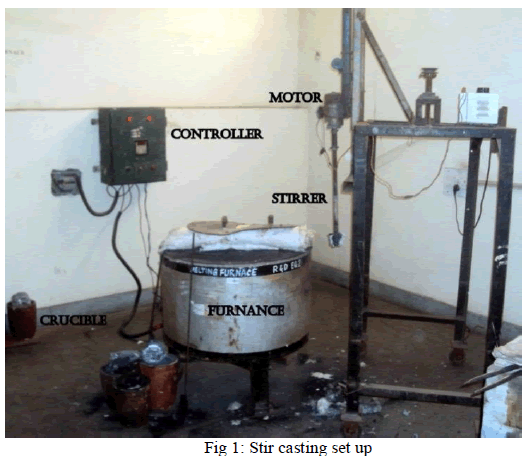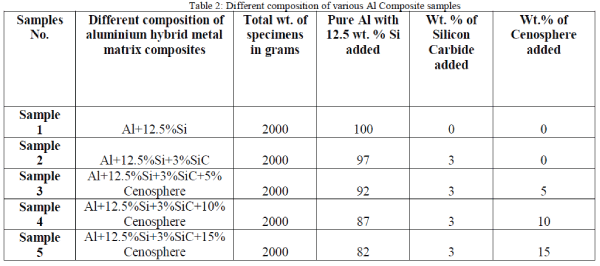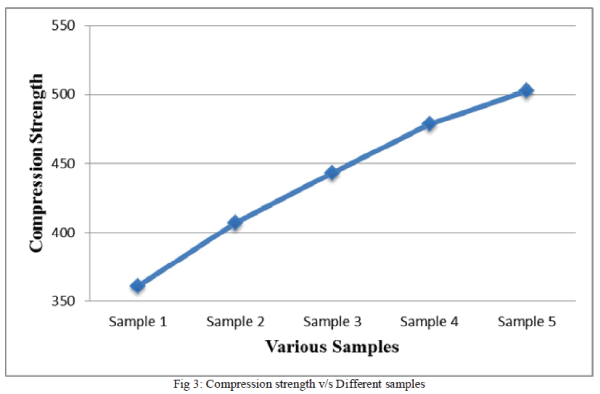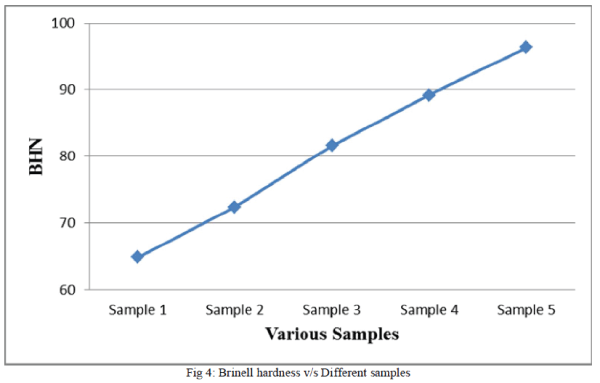ISSN ONLINE(2319-8753)PRINT(2347-6710)
ISSN ONLINE(2319-8753)PRINT(2347-6710)
Vinoth M.A1, Arun L.R2, Bhimagoud Patil1
|
| Related article at Pubmed, Scholar Google |
Visit for more related articles at International Journal of Innovative Research in Science, Engineering and Technology
This paper deals with the fabrication and mechanical characterization of aluminium-silicon based hybrid metal matrix composites reinforced with silicon carbide (SiC) and cenosphere particulates for engine applications were investigated. The required material properties for engine applications are greater strength, light weight, controlled thermal expansion, high thermal conductivity and good wear resistance. In the present investigation pure Al-12.5 weight % Si alloy reinforced with 3 weight % of SiC with 5, 10 and 15 weight % of cenosphere particulates were casted by stir casting technique. These materials are developed for piston, cylinder sleeve and engine blocks. The mechanical properties like ultimate tensile strength, compressive strength, density and hardness of the hybrid metal matrix composites have been measured. It has been clearly proved that the ultimate tensile strength, compressive strength and hardness of the composite is increased and density of the composite is decreased with increasing the weight percentage of reinforcements.
Keywords |
| Stir casting technique, Mechanical properties, Pure Aluminium, Silicon, SiC, Cenosphere, Engine applications |
INTRODUCTION |
| In recent years there has been a rapid increase in the utilisation of aluminium hybrid metal matrix composites. The hybrid metal matrix Composite is a structural material which consists of two or more particulates. However aluminium hybrid metal matrix composites are the most common MMC’s and commercially available ones due to their economical production. Conventional materials like cast iron, steel, brass etc. will fail due to cracks initiation and propagation will takes place within a short span. To overcome this problem conventional materials are replaced by aluminium alloy materials due to their outstanding mechanical properties. The use of advanced composite materials like Al/SiC/Cenosphere metal matrix composite is increases in various fields such as astronautics, aeronautics, high speed train fields and automobile industries. |
| The developed aluminium metal matrix composites is considered to be a promising material for the high temperature applications. Because composite materials are important engineering materials due to their excellent mechanical properties such as higher strength to weight ratio, improved hardness, good wear resistance, low density, good thermal conductivity and low coefficient of thermal expansion. It is particularly due to increase in performance and weight saving for more reduction of fuel consumption. |
| D.Rudnik et al [1] described the limitations which result from the material and design of contemporary composite materials of aluminium alloy matrix for pistons and other engine components to improvement of engine operation features. |
| Jonathan A. Lee [2] used Al-Si alloy with silicon content ranging from 6% to 18%. By increasing silicon percentage the alloy exhibits excellent dimensional stability, low thermal expansion, high surface hardness and wear resistant properties. |
| Haizhi Ye [3] described the microstructure of Al-Si alloy and its effects on these material behaviours. And also they discussed the alloying, composite production and casting techniques. |
| K. L. Meena et al [4] they prepared (Al-6063)/SiC MMC’s were fabricated by melt-stirring technique. The MMC’s bars were prepared with varying the reinforced particles by varying weight fraction. It was observed that ultimate tensile strength, hardness and density increases with the increase in reinforced particulate size. % of elongation and impact strength were decreases with increase in reinforced particulate size. |
| Dr. Ali Hubi Haleem et al [5] they developed aluminium metal matrix composites by using stir casting technique and they evaluated the impact strength, material toughness and hardness. They also observed that hardness and material toughness were increased 1.84 and 2.16 times respectively. |
| Tamer Ozben et al [6] they presented the results of mechanical and machinability properties of SiC particles reinforced with aluminium MMC. It was observed that increase of reinforcement element produced better mechanical properties such as impact toughness and hardness but tensile strength showed different trend increased up to 10 wt.% of SiC particles reinforced and then decreased when 15 wt.% of SiC particles reinforcement addition. |
| Neelima Devi C et al [7] used Al and SiC by varying weight fraction with (5%, 10%, 15% and 20%) of SiC. They observed that the weight to strength ratio for aluminium silicon carbide is about three times that of mild steel during tensile test and also they indicated the Al-SiC composite material having less weight and more strength. |
| J P Pathak et al [8] they prepared the Aluminium-Silicon-Silicon Carbide composite by mechanical mixing with SiC powder. They found that the strength, hardness and wear resistance of composites increased with increase of silicon carbide content. |
| Dunia Abdul Saheb [9] had used by varying weight fraction of SiC, graphite and alumina (5%, 10%, 15%, 20%, 25%, and 30%), while graphite weight fraction 2%, 4%, 6%, 8% and 10% keep all other parameters constant. They observed that the increasing of hardness by increase in weight percentage of ceramic materials. |
| Hyo S. Leea et al [10] they fabricated SiC/Al-Si MMCs were by the powder metallurgy process and they observed the hardness of SiC/Al-12 wt. %Si MMC was higher than that of SiC/Al-10 wt. %Si MMC due to the higher Si content. |
MATERIAL DESCRIPTION |
2.1 METAL MATRIX |
| The matrix material used in this investigation was pure aluminium with 12.5 weight % of silicon alloy. Because aluminium is the common metal with density of 2.7g/cm3 which is approximately one third value of steel and the third most plentiful element on earth’s crust. Silicon is good in metallic alloys and very inexpensive material which has a low density of 2.34 g/cm3 and it may be an advantage in reducing the total weight of the cast component. Aluminium- Silicon alloys are the most versatile materials depending on the weight per cent of silicon the Al-Si alloys are classified in to three categories such as: i) Hypoeutectic (<12% Si), ii) Eutectic (12-1 3% Si) and iii) Hypereutectic (14-25% Si). |
2.2 REINFORCEMENT MATERIAL |
| The role of the reinforcement in a composite material is tends to change the mechanical characteristics. All the different reinforcements used in these composites have different behaviours and so it will affect the mechanical properties of the composite in different ways. The reinforcements used in this experimental investigation are:- |
SILICON CARBIDE: |
| Silicon carbide is the chemical compound of carbon and silicon with chemical formula of SiC. It is also known as carborundum with density of 3.21 g/cm3. Chemically high grade pure silicon carbide particulates having average particle size of (<50μm) are used. Al-SiC is the most widely used composite material for many commercial applications. |
CENOSPHERE: |
| Cenosphere is one of the most inexpensive and unique free flowing powders composed of hard shelled, hollow, minute spheres which has low density of less than 1.0 g/cm3 reinforcements whose chemical composition in weight % is listed in Table 1. It is estimated that present to an extent of about 1 % in fly ash from thermal power plants. This experiment has mainly done to utilize an inexpensive material to reduce cost of metal matrix composites. |
 |
EXPERIMENTAL METHODOLOGY |
| The fabrication of hybrid metal matrix composite used in this investigation was carried out by stir casting method also called as liquid state method because this is the simplest and the most cost effective method of liquid state fabrication. Here melting was carried out in a clay-graphite crucible furnace and a stir casting setup consisted of a resistance furnace and a coated stainless steel stirrer assembly was used to fabricate the composite where the setup is shown in Figure 1. Here pure Al-12.5wt. %Si alloy was commercially prepared in a resistance heated muffle furnace and then casted. |
| After that measured quantity of silicon carbide and cenosphere was preheated at 450°C for 3-4 hours to remove gases and moistures from the reinforcements. Then weighed quantity of aluminium-silicon alloy was taken in the billet form and kept in clay-graphite crucible and melt temperature was raised up to750-800 degree Celsius. |
 |
| During melting aluminium alloy hexachloroethane pallets were added to remove the atmosphere gases particularly hydrogen. Suppose if these gases are not removed it will affect the casting. At this stage the preheated Silicon carbide and cenosphere particles were added with a spoon at the rate of 10-30 g/min into the melt and mixed manually by stirrer with speed range of 350 to 890 rpm was maintained between 8 to 10 minutes. By the mean time the mould was preheated and choco powder was applied in mould to avoid shrinkage of casting material. The five different samples were casted those compositions are given in Table 2. |
 |
| At last the melted matrix with the reinforced particles was poured into the mould. Then it was allowed to solidifying about 3-5 hours and conform the solidification before remove the casting from mould. |
RESULTS AND DISCUSSIONS |
4.1 DENSITY MEASUREMENT |
| The density of materials plays a very important role in MMC’s. Here density of the composite material was estimated by comparing the experimental and theoretical density of each composition of the composites produced. For density measurement specimens were cut from various sections from the casted composite with 30mm diameter and 40mm length. The experimental density of the composite material was estimated by the archimede’s principle. Then the specimens were cut from various portions was separately weighed in air and weighed in water. Finally experimental density values were obtained by using this expression: |
| ρ = (weight in air/weight in air-weight in water) x ρ water |
| Theoretical density of the composite material was evaluated by applying the rule of mixtures according to the weight fraction of reinforcement by the following relations: |
| ρ Al MMC’s = (wt.%AlâÃâ¬ÃÂSi×ρAlâÃâ¬ÃÂSi) + (wt.%SiC×ρSiC ) + (wt.%Cenosphere×ρCenosphere) |
| The porosity of the composites was determined by using the following rule: |
| % of porosity = [(ρ Theo - ρ Exp.) ÷ ρ Theo] × 100% |
| The results indicated that the density of composite decreasing with increase in weight percentage of reinforcements. The density estimated for different compositions are shown in Table 3. |
 |
4.2 TENSILE TEST |
| To determine tensile strength the casted specimens were machined to standard ASTM dimensions and then tensile test has been conducted on each composite specimens using universal testing machine at room temperature. The experimental results clearly show that addition of reinforcement particles considerably increases the ultimate tensile strength of composites. The tensile strength estimated for different compositions are shown in Fig 2. |
 |
4.3 COMPRESSION TEST |
| The compression test was done at room temperature and different casted specimens were machined according to ASTM standard. Then testing was carried out in universal testing machine and it was found that compression strength of the various composites increasing with the increase in reinforcement weight percentage. The compression strength evaluated for various compositions are shown in Fig 3. |
 |
4.4 HARDNESS MEASUREMENT |
| The hardness of the composites was evaluated by using the brinell hardness testing equipment and experiments have been done by varying weight fraction of composites. Then test specimens cut out from each composite composition were polished to obtain a flat and smooth surface finish. Hardness test was carried out on each specimen by using a load of 250 kg and a steel ball of diameter 5 mm with loading time was 30 sec as indenter. The brinell microscope was used to predicate the diameter of impression made by indenter. For each sample multiple hardness tests were performed on each specimen three readings were taken and mean value was considered. It has been observed that hardness of the casted composite material was comparatively higher than the un-reinforced material. The hardness determined for various compositions are shown in Fig 4. |
 |
CONCLUSIONS |
| The stir casting method was successfully used to fabricate the Al-Si, Al-Si-SiC and Al-Si-SiC-Cenosphere of various concentrations of composites to make uniform distribution of the reinforced particles. Based on the experimental observations and results the following conclusions have been drawn: |
| • Density of composites decreased with increase in weight percentage of reinforcements. Hence it was found that Al-Si-SiC-Cenosphere composites shows better result than the Al-Si and Al-Si-SiC composites. |
| • It is found that that tensile strength starts increases with increase in weight fraction of reinforcements. The best tensile strength result has been obtained at 15% weight percentage of cenosphere and 3% weight percentage of Silicon Carbide. |
| • The experimental results clearly show that compression strength of composites increased by increasing the weight fraction of reinforcements such SiC and Cenosphere. |
| • It appears in this study that hardness of aluminium metal matrix composites was increased by increase in reinforcement contents. |
5.1. SCOPE OF THE FUTURE WORK |
| The study can be extended by the addition of other materials with pure aluminium and cenosphere. Impact, wear and thermal characteristics studies can also be carried out. |
References |
|